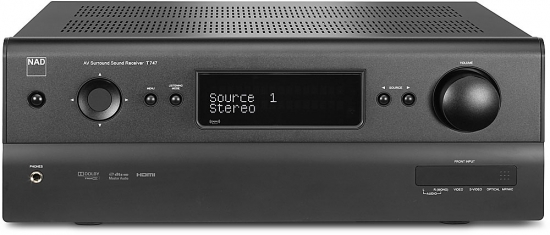NAD T747 AV-receiver
NAD adheres to its branded principle, which can be formulated as follows: "excellent results for little money." In other words, nothing more, just the necessary functions and maximum attention to the signal path. NAD T747 receiver has HD decoders, an Audyssey auto-calibration system, ports for connecting ipod and a DAB broadcast adapter, a Faroudja DCDi video converter and advanced zone functions (independent source selection and volume control). Again, we see here an excellent end section on discrete elements with proprietary technology of adaptive power supply Power Drive. However, on the example of T747, some excesses became visible. Trying to make the front panel more concise, the designers reduced the number of buttons on it to such an extent that some operational functions are now available only from the remote control, and some of them - only through the on-screen menu. At first, when you master the capabilities of the receiver, this is inconvenient, but after a full system setup it becomes a plus - the likelihood that an inexperienced user accidentally knocks down the settings is negligible. But, admittedly, NAD saved on the display. Such an low-informative device does not decorate the device for more than a thousand dollars.
NAD T747 sounds via analog 7.1 input rather than just good, but almost divine (of course, for its price range). I don't want to find fault with such a sound - it carries away one hundred percent. Microdynamic resolution is excellent over the entire range. T747 maintains impeccable intelligibility of dynamic contrast transmission and high tonal neutrality. Even the most energetic musical compositions sound densely, transparently and lively. Bass pleased too - extremely structured. In the middle lane there is beautiful musical plasticity, and in the upper case a delicate graceful figure appears. Nevertheless, we are simply obliged to point out shortcomings, even the most insignificant ones. Firstly, NAD T747 cannot be called absolutely neutral - the receiver gives the lightest warm tint in MF/HF to all music programs. Secondly, the sound stage has some specificity. The scale is opened, there is acute localization, depth is well expressed. However, at the edges of the base, the depth is no longer formed as clearly as in the center.
When switching to digital audio inputs, many advantages were not found - only the information content in the middle register improves. Otherwise, there is a slight degradation: the sound stage turns out to be less deep, the character of the bass changes (it becomes harder, but less informative), the dynamics in HF deteriorates. As a result, the sound is somehow ordinary and formal. Checking the sound quality via HDMI revealed nothing new - this type of connection, when audio data is transmitted along with the video stream, gives a compromise result.



